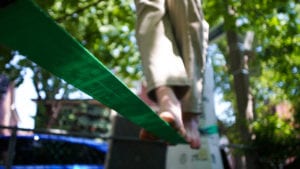The Slackline and Yosemite Climbing
Slacklining has been a part of rock climbing for decades. Between the balance and beta it makes sense, but which slackline should you buy?

Yosemite National Park has come to father that which North American rock wranglers hold most dear. While climbers might not find surprise in its great history, they may not know that Yosemite also brought about the daring and dynamic Slackline.

Although tightrope walking has existed since the 1800s, slacklining only came about in the 1950s. Reasonably, calling the loose-chain-walk of this decade “slacklining” might seem a little off base, but the loose cables in many ways represented this newly popular sport.
Where a tightrope comes under an almost unbendable tension before and during the walker’s run, the slackline comes under tension only after the user weights the line. In this way, even the loose chains of beatnik Yosemite provided a slacklining platform.
Skip forward a few decades and rock climber Adam Grosowsky would sling some tether and begin a new tradition. The discipline became extremely popular in the climbing community and would soon characterize the climber’s rest-day activity. The balanced discipline became synonymous with the Yosemite climbing scene and, given time, would reach new heights in both difficulty and altitude.
As in climbing, new routes would establish themselves around the valley. Eventually Dean Potter, a legend of Yosemite climbing, would begin outrageous solos protected by wing-suits and parachutes, high above the valley floor.

In this last decade, slacklining has become a sport unique from climbing, though many gyms across North America still feature slacklines either in or about their facility or programming. In 2019, BC slackliner Mia Noblet would join Germany’s Lukas Irmler to cross a two-kilometre slackline stretching 200 metres above an open pit in Asbestos, Quebec. Noblet would cross in 58 minutes, sharing the longest-highline record with Irmler.
Today, slacklining exists in many forms. While highlining, free soloing, and blindfolded walking each stick well within the rock-climbing context, Slacklining has fixed itself between the pillars of free-style form and competition.
Slackliners today pull gymnastic, trampoline-esque tricks on a thin strip of webbing relatively low to the earth. The result is almost indescribable.
Although climbers will continue to bicker over whether or not climbing technique benefits from the balance and body-awareness slacklining requires, the tether-based pass time remains one of climbing’s best rest day activities.
While many will surly see the value of slacklining both as a sport and supplemental activity, it can seem difficult to get into. Do not worry, all you need is a line.

Slackline Industries: Base Line Kit
For those looking to break into the sport, Slackline Industries Base Line offers the lowest cost for the highest quality. If you have used a slackline before, there is a good chance this is that line.
At $79.99 USD or $119.99 CAN, the Base Line Kit comes complete with a two-piece, 50-foot band of easily installed webbing. The ratchet tensioner and carry bag come with two pieces of tree-protection that work to keep your bark-bearing friends safe between your steps. While some have complained that these tree protectors do not quite cover the entire tree, a bit of cloth or cardboard will suffice just as well if required.
At two-inches wide, this line, and its custom weave pattern, offers a tricky platform that forces the user to both focus and flow, waving their arms about to keep the centre of mass centred. The tighter you ratchet it, the easier it becomes, although it will take a solid hour of practice before you find yourself approaching a comfortable pace across the line.
For climbers, the problem-solving capacity of the product is extremely appealing. Much like slab climbing, power has little use here. Technique is the name of the game. With that said, every slackliner must find their own path across the webbing.

Slackline Industries: Aggro Line Kit
For the more experienced slackliner, the more elastic Aggro Line offers high-performance at a premium. With a $159.99 USD price tag, $198.99 CAN, the green line might seem expensive, but at 100 feet (30 metres) in length, the line offers better value for money than the its peer.
Naturally, the slackliner will have to have some long-lined aspirations for that to be the case, but this high-performance product will attract users with those sorts of goals.
As with the Base Line, the Aggro Line Kit comes complete with a carrying bag and tree-protectors. The lines differ at the ratchet and in the materials of the line. The Aggro Line features an Alpha Ratchet that allows for greater leverage for greater tension. This pairs with the custom-designed trampoline-style webbing used to produce extra bounce for dynamic tricks.
The Gripped Editor did not have the ability to try these tricks but can speak to the tension of the line. It felt easier to walk on than the Base Line.
Ultimately the question of whether or not you should pick up a slackline depends upon two things. The first comes down to natural interest while the second comes down to time spent outdoor climbing. If you think you will find yourself in crags this summer, camping and climbing, resting and waiting, the Slackline is for you. Few things make rest days quite as fun without tiring you out for climbing. Plus, if Yosemite locals are to be believed, it just might improve your technique as well.



